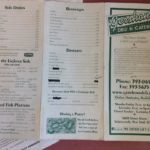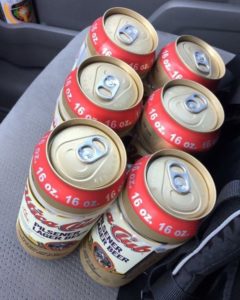 Ah, Utica Club. Craig brought Utica Club. He brought a few other beers. Beers that even came in caged cork topped bottles. But he brought Utica Club. It’s a funny beer. An old school macro lager made by a regional craft brewery. Is it hidden craft? Faux macro? Whatever it is, it’s five bucks for three litres at central NY gas stations. Summertime beer. Maybe even a cure for the summertime blues. Maybe. We talked over a pint or two before turning to a few more complex beers. Sweetish with a well placed jagged edge. Everything in its proper place. Nothing off or awkward. A beer for craft’s endtimes. Both pure and XX. According to the label. We talked of these endtimes. I blame Boak and Bailey, writing that non-derivative book that no one else will match. Takes the wind from the sails, didn’t it. So much for no one ever going beyond what’s gone before, been done before. Things get confused once those sorts of things get going. Not knowing your place. Can’t tell heterodox from orthodox. Hard to find which side of the map is up. Things go round and round. The saison driving north from Virginia or the Carolinas was wonderful after the cork popped. But so many are in a similar way, aren’t they.
Ah, Utica Club. Craig brought Utica Club. He brought a few other beers. Beers that even came in caged cork topped bottles. But he brought Utica Club. It’s a funny beer. An old school macro lager made by a regional craft brewery. Is it hidden craft? Faux macro? Whatever it is, it’s five bucks for three litres at central NY gas stations. Summertime beer. Maybe even a cure for the summertime blues. Maybe. We talked over a pint or two before turning to a few more complex beers. Sweetish with a well placed jagged edge. Everything in its proper place. Nothing off or awkward. A beer for craft’s endtimes. Both pure and XX. According to the label. We talked of these endtimes. I blame Boak and Bailey, writing that non-derivative book that no one else will match. Takes the wind from the sails, didn’t it. So much for no one ever going beyond what’s gone before, been done before. Things get confused once those sorts of things get going. Not knowing your place. Can’t tell heterodox from orthodox. Hard to find which side of the map is up. Things go round and round. The saison driving north from Virginia or the Carolinas was wonderful after the cork popped. But so many are in a similar way, aren’t they.
Category: New York
More References To That Shadowy Taunton Ale
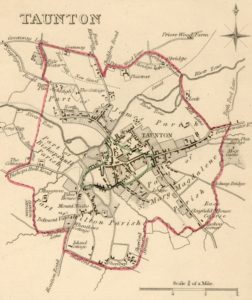 Attentive readers will recall that I have a slow side project in figuring out what I can about Taunton ale. It was a bit of a by-catch to the whole Albany ale thing with references to it showing up in central New York around the time of the American Revolution. When I got to the New York State Library in Albany in 2012, I found a mass of references to it being sold in New York in the 1750s and 1760s. And then it pretty much fell off the table. I couldn’t find anything more online. But three more years means three more years of people throwing everything they can find onto the Information Super Highway. So what is there to add to the story now?
Attentive readers will recall that I have a slow side project in figuring out what I can about Taunton ale. It was a bit of a by-catch to the whole Albany ale thing with references to it showing up in central New York around the time of the American Revolution. When I got to the New York State Library in Albany in 2012, I found a mass of references to it being sold in New York in the 1750s and 1760s. And then it pretty much fell off the table. I couldn’t find anything more online. But three more years means three more years of people throwing everything they can find onto the Information Super Highway. So what is there to add to the story now?
First, it was being exported to other parts of the British empire than just pre-Revolutionary New York. In 1774, Taunton ale is described as being one of Bristol’s exports to Jamaica along with products like West country cyder, cheese, leather, slate, grindstones, lead, lime for temper and Bristol water. Another record shows a ship for Jamaica in 1776 being loaded with Taunton ale, household goods as well as “volumes of entertaining history.” Taunton also is mentioned a number of time in The Bright-Meyler Papers: A Bristol-West India Connection, 1732-1837. In the entirely uncomfortably titled “Letters on the Cultivation of the Otaheite Cane: The Manufacture of Sugar and Rum; the Saving of Molasses; the Care and Preservation of Stock; with the Attention and Anxiety which is Due to Negroes and a Speech on the Slave Trade …”, what appears to be an 1801 guide to running a slave sugar plantation again in Jamaica, a warning is given on being too generous with one’s manager:
A very injudicious mode of remuneration, established by folly, and imitated by thoughtlessness, is that of fixed and stated presents. Such are, on many West Indian estates, invariably ordered for a manager, whether he is deserving of them or not; whether he makes fifty hogsheads, or five hundred; whether his Negroes increase or diminish; without regard to the situation of the stock, or to the improvement or neglect of any article entrusted to his care. These annual compliments consist sometimes of provision; as beef, butter, hams, and other articles of domestic consumption. But they are not judicious, even if they are merited. For their cost would invariably be turned to greater advantage, by an industrious economical manager, than the presents which are bestowed on him. Some of these acknowledgments, too, are pernicious in their nature: operate, though not intended, as an incentive to vice, and a seduction of the manager from his business. Such is the cask of Madeira before alluded to; and such are casks of porter and Taunton ale, with cases of claret. All these idle substitutes for judicious remuneration should be abolished, and proprietors should constantly reward their managers, in proportion to the services which they render, and the prosperity which they bestow, on whatever is entrusted to their care.
In 1808, a gazetteer states that large quantities of malt liquor called Taunton ale was also being sent to Bristol for exportation. Around the early 1820s, Taunton ale was selling in Bristol for 9s 6d a dozen quarts compared to 10s for Burton and 7s for porter.
Next, there is clearly a lifestyle aspect to Taunton ale in the beginning of the 1800s. It’s a beer for the destination traveling poet. Volume 30 of The Scots Magazine from 1777 included The Poem “In Praise of Tobacco” which included the lines “Say, Muse, how I regale, / How chearfully the minutes pass, / When with my bottle, friend, and glass, / Clean pipes and Taunton ale.” Yikes. In a 1797 letter, the clearly better poets Coleridge, Lamb and Southey are described as drinking Taunton along with a meal of bread and cheese. In the 1804 annual of Sporting Magazine, Taunton is described as most famous for that best of human beverage, good ale; though the author have I have before quoted thus mentions the attachment of the natives to it with some regret: “Hail Taunton! thou with cheerful plenty bless’d, / Of numerous lands and thriving trade possess’d, / Whose poor might live from biting want secure, / Did not their resistless ALE their hearts allure.” More bad poetry. Not sure how that reflects on the quality of Taunton ale.
What was it? The 1824 booklet “The Spirit, Wine Dealer’s and Publican’s Directory” gives some sense of the beer in its treatise on “the art of making vinegar, cider, perry and brewing malt liquors – and particularly Taunton strong beer and ale.” We are told the strong ale takes eight or nine bushels of the best pale malt to the hogshead as well as six pounds of Farnham hops – but use east Kent hops if the beer is meant to be kept for two or more years. Strike at 160F, cover the lot with dry malt or sweet bran and let it sit for three and a half hours. Strain off and boil the wort with the hops of an hour. A half hogshead of strong ale results from the first running with ale and table ale the second and third. Its an odd sort of set of instructions for something written 191 years ago. It all reads a lot like a 1960s Amateur Winemaker home brewing article. The short guide recommends spirit dealers lower the proof of their rum by adding a mix of two-thirds water and one third Taunton strong for softness. It is a soft water zone so they may have had a point.
Also, Taunton seems to become the drink of a certain sort of well placed gent, especially when from one particular brewer. In Benjamin Disraeli’s letters from the mid-1830s, he tells a correspondent that Eales White would send a barrel of Taunton ale which he describes as “something marvelous.” The 1851 annual of Sporting Review describes the morning of a hunt and the reception in one great house:
The merry young sportsmen returned to the house, not however till they had been gratified by the safe arrival of the jumper, who, led by Thomas, was placed in a stall perfectly fresh and fit to go; by which time things were looking more cheerful. A bright fire blazed on the dining-room hearth; breakfast was prepared, the sideboard groaning with good substantial cheer; and even the somewhat flamingo-faced butler had contrived—knowing the squire’s peculiarity, or, I should rather say, punctuality on hunting mornings—to rouse himself from a most agreeable nap, and honour the lower dominions with his portly presence. In fact, as far as I can recollect, he was decidedly the most substantial, if not the most important, person of the Hall or neighbourhood – et pourquoi non? Excuse a French term, for he was certainly most useful in his special department; added to which, he brewed without exception the best ale I ever tasted: and if-so-be it precisely suited his own palate—what then? all the country round pronounced it undeniable. Stogumber beer was, or rather is, mere wish-wash in comparison, though vastly agreeable; and White’s Taunton ale alone could bear it any comparison.
Martyn cleared up the Stogumber question in 2011, but it is White which is clearly the name which appears associated with the best Taunton ale in mid-1800s English society. The report of Crimean Army Fund Committee of 1855 also mentions Eales White, Esq. of the Taunton Ale Brewery as a contributor to the cause among those who gave presents of wine, spirits or beer. Probate of the will of Eales White, Brewer of Taunton, Somerset was before the court in 1855. He has a rather splendid headstone.
And that is it. A beer for the bastardly late 1700s Jamaica slave plantation manager, for the great and crap poets of the turn of the century as well as for the gentry of the mid-1800s. Three dislocated bits of society, no? Well, they do sorta all have the well placed slacker theme going for them. Is that what the beer represented? The lazy entitled bastards’ reward?
A Week Off In April To Get Things Done
It’s either a sign of a well organized life or one with not enough in it. The spring holiday to get the taxes done, straighten out the gardening, fix the step and have some naps. And opening week baseball. Maybe some first round playoff hockey, too. The one thing I am not doing is writing a book. This time last year I was in the middle of writing three books each of which has turned out to be, err, cult classics. Happy readers. Low sellers. Good reviews. Niche huggers. I should have known. Beer writers are either fat or thin. Both from the same cause – anxtity yips. Told a pal once his mistake was doing for a job what I do for a hobby. Beer may still pay for itself. It just doesn’t take me all that far anymore when it does. That’s fine. Been since 2010 that the prospect of a truly idle summer lay before me. I was reading about brainy books back then five years ago today. Probably gave me ideas. Planting some carrot and lettuce seeds will help with that. Tiny seeds in the cold early spring soil don’t give you ideas. Just salad.
New York: Last Bar Seat, Allen Street Pub, Albany
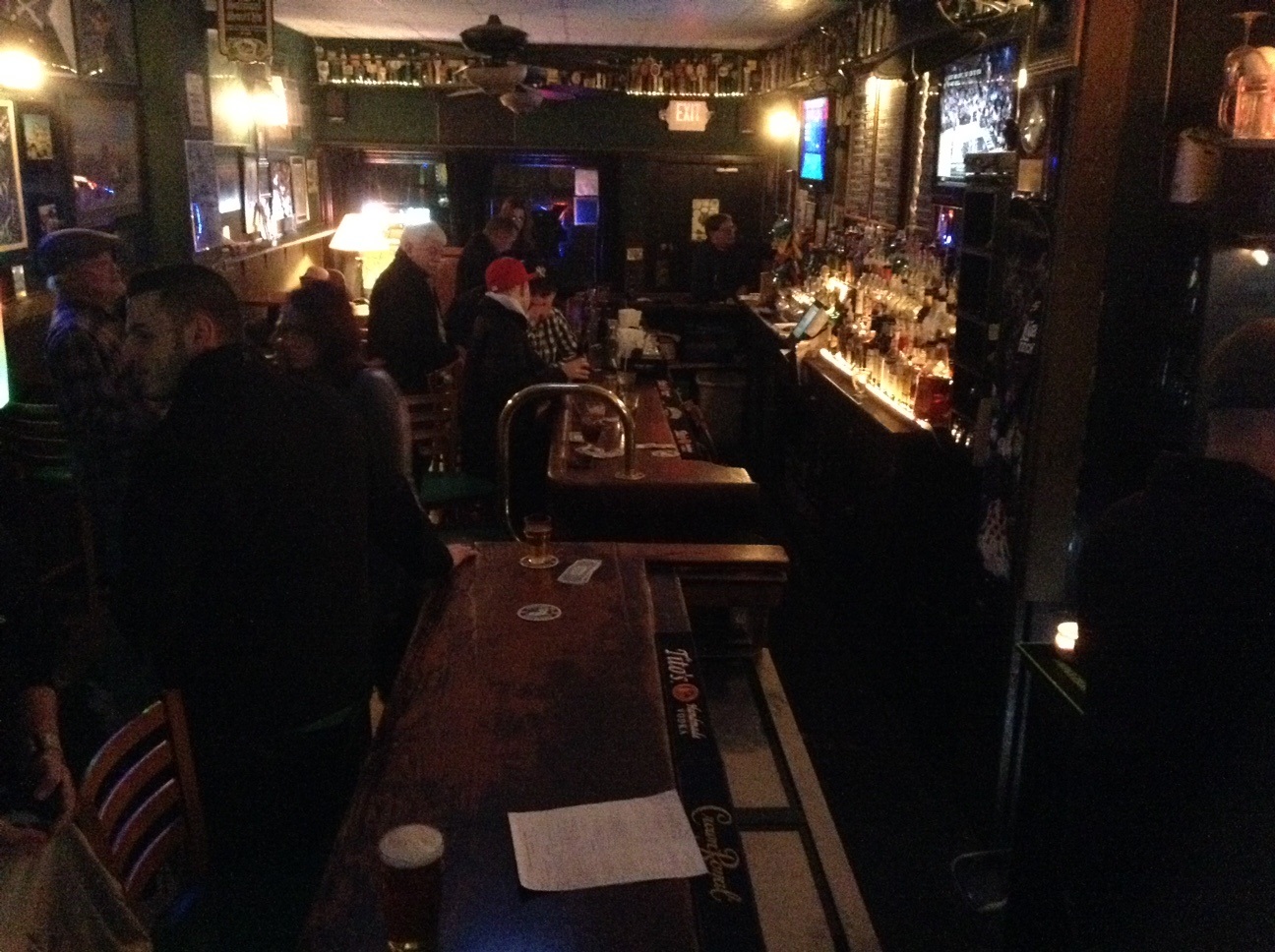 I have to say. I didn’t expect it. Don’t get me wrong. I have known for a long time that I love neighbourhood bars in the US. I spent a great summer evening a decade ago with pals of a pal in Maine watching the All-Star game in a place down by the working wharves. The place was the shape of a cinder block and was made up entirely of cinder blocks. I drank Allagash White and then PBR before the money ran out. I love the idea of walking down the block to a place for a beer even though it does not exist in much of Canada outside of the cities where green things don’t grow. Doesn’t exist in much of any place where the planners have played a role. But there it was. And there I was, too.
I have to say. I didn’t expect it. Don’t get me wrong. I have known for a long time that I love neighbourhood bars in the US. I spent a great summer evening a decade ago with pals of a pal in Maine watching the All-Star game in a place down by the working wharves. The place was the shape of a cinder block and was made up entirely of cinder blocks. I drank Allagash White and then PBR before the money ran out. I love the idea of walking down the block to a place for a beer even though it does not exist in much of Canada outside of the cities where green things don’t grow. Doesn’t exist in much of any place where the planners have played a role. But there it was. And there I was, too.
The photo above is from the end of the bar at the Allen Street Pub in Albany, New York. That’s it. If I was a cheese eating school boy, I might insert some sort of pretendy disclaimer but let’s be honest – free beer is “money + alcohol” innit. Paul gave us the run of the taps though I hope the tipping went some way to match the beers poured for us. There is no avoiding the history of the western world. The bar is owned by Craig’s pal of decades. Paul. The place opened right after prohibition ended and sits among houses on a side street. A municipal planner’s nightmare. It’s filled with local memorabilia with a definite lean towards Albany’s history of military service. It’s also filled with folk from nearby having a beer. Normal. Beer in a normal place.
Here’s the thing. Over the few hours we were there I came to the understanding that this was one of the greatest times in a bar I have ever had. It was perfect. It was so perfect that while one in our group was keen to take me on at an argument about craft beer, I realized I was sitting in a dark tiny pub in a foreign land sucking on a rosemary laced saison as Led Zep’s “Kashmir” roasted out the speakers. While, yes, dark and tiny it could serve as a test site for the Bose speakers Paul had installed. The narrow bar had five distinct spaces: cans in the rear, the cooler with its kegs and bottles, back of the bar plus the old bar top and the new one. If you look at that photo above you will see the division. Before he took it over and expanded, the tavern was just that bit at the front – maybe 18 by 30 feet tops. When we got in the place, we grabbed the back bar with its four seats. The front two-thirds of the place was already well settled by guys drinking macros or a shot or both having a good Friday night. Mere feet away I was having a pint of Black IPA with a balancing splash of brown ale handed to me. And then something else. Again, let’s be honest: I was not conflicted. I had given in. Only an idiot wouldn’t.
What did it all mean? It was more like a village pub in some place where I have family in Scotland than most places I had been in North America. Think I had only seen a place this small on this side of the Atlantic maybe in Newfoundland. No dive and not even a joint. A place in the neighbourhood. Normal. Three beer engines, too. He plans to add more. Paul is even running a cask festival in a few weeks. I expect to be in Canada when that is on. Probably in my basement watching TV. A couple of bus rides away from the next nearest good place to hang out. Thanks a lot, fifty years of urban design.
Notes On Turning Into A Book Fair Carny, Etc
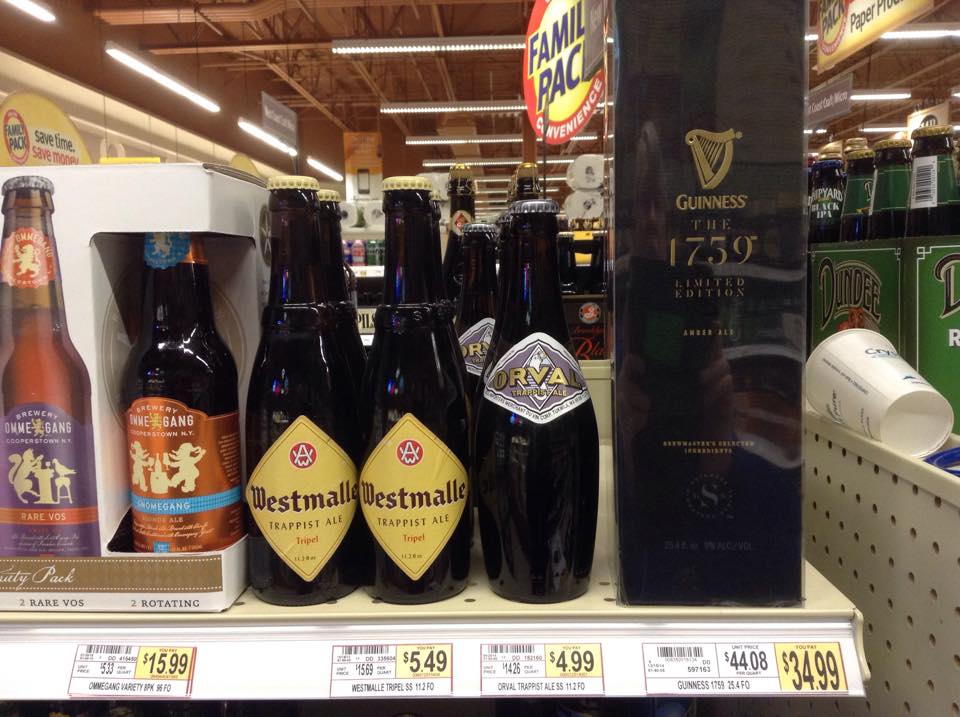 I had not expected to make myself into a book fair carny but forty-five quiet minutes into the four hour book booth manning at last weekend’s NY State Brewers Association Festival I looked at Craig and said something to the effect of “we better think of something quick or we are going to hate each other around three hours from now.” It’s not that the fest wasn’t swell so much as it was a beer fest, not a book fest. So… I stood up and began to shout “GETCHA BEER BOOKS… GETCHA BEER BOOK HERE!!!” until I was quite hoarse. Sales picked up rapidly. And they continued to pick up as folk drank more beer. So, two tips for the beer book selling public for the price of this one post: (i) act like an idiot and (ii) act like an idiot in front of folks getting drunk. Which leads me to a few other thoughts:
I had not expected to make myself into a book fair carny but forty-five quiet minutes into the four hour book booth manning at last weekend’s NY State Brewers Association Festival I looked at Craig and said something to the effect of “we better think of something quick or we are going to hate each other around three hours from now.” It’s not that the fest wasn’t swell so much as it was a beer fest, not a book fest. So… I stood up and began to shout “GETCHA BEER BOOKS… GETCHA BEER BOOK HERE!!!” until I was quite hoarse. Sales picked up rapidly. And they continued to pick up as folk drank more beer. So, two tips for the beer book selling public for the price of this one post: (i) act like an idiot and (ii) act like an idiot in front of folks getting drunk. Which leads me to a few other thoughts:
=> “To grangerize: to illustrate with material taken from other published sources, such as by clipping them out for one’s own use.” Isn’t this what beer blogging really is?
=> Thirty-four dollars and ninety-nine cents!?!? I am sure some young aspiring consulting craft beer mixed revenue dreamer has a grab bag of cliches by which such things are justified but… thirty-four dollars and ninety-nine cents!?!? Seen at the Cicero, NY Wegman’s grocery store.
=> Chad was more sensible. He had some beer, too. I just shouted a lot.
=> I consider the fear of sweetness and the denigration of crystal malt to be hallmarksof this era which shall be mocked in the new future after the paradigm collapses. But I can say that about a lot of things.
=> I have no idea about how many pubs or taverns represents a crawl but some people have very fixed ideas. Having done one, as one must, by taxi in Toronto in the last year I would accept a walking four-stop crawl in two small neighbouring villages myself.
=> Words that beer bloggers might have recently chosen not to use: intended, unravelling, instantly.
=> My answer? Use the machines – whether you own them or not? You’re a “brewery” while the others can use “brewing” or “beer company” or something else.
There. Monday notes. It’s thawing out there. We are a long way from warm but the dripping roof has created the driveway trickle which leads to the gurgling roadside drain.
Session 97: A $40 Room And Maybe Free Beer
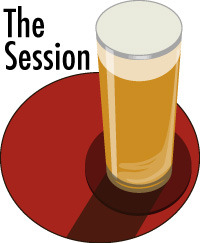 We are asked to write about up and coming beer destinations for this month’s edition of The Session but I wonder if I’m living the rougher and readier reality. Beer travel? From what I see it often includes some sort of relapse into undergrad lifestyle. I am having bit of a creeping feeling that this two star hotel on the old four-lane route out of Albany, New York might be serving that up for me this weekend. But the room ain’t bad and soon pals will arrive. The solvent againt will prove to be the bond.
We are asked to write about up and coming beer destinations for this month’s edition of The Session but I wonder if I’m living the rougher and readier reality. Beer travel? From what I see it often includes some sort of relapse into undergrad lifestyle. I am having bit of a creeping feeling that this two star hotel on the old four-lane route out of Albany, New York might be serving that up for me this weekend. But the room ain’t bad and soon pals will arrive. The solvent againt will prove to be the bond.
See, as I mentioned, I am attending the New York Brewers Association fest and conference at some other fancy pants hotel without $38 CND rooms. And to be fair I got this deal in Hotwire weeks ago. But it illustrates one of two ways beer and travel interact for me. I go to beer events or I find beer wherever I go. I have never traveled to find only beer. But that was covered in Session #93 four months ago. Not to mention sorta during Session 29.
Beer destinations? You may want to have a good look in the mirror if you dwell too much on the idea. You will find good beer on life’s highway if you are good at noticing stuff. You will also find other good stuff if you keep you eyes open for that as well. And if you don’t want your grand children to think you were an alcoholic back in the day get some photos of that stuff, too, when you travel. Travel gives you perspective. Or at least it should. Jeff knows. Go hicking in Franconia and you’ll find some good beer along the way. And, if not beer, wine or rum or even a nice cup of tea. It’s a big world out there. Don’t let the grandkids down.
I Never Go To Beer Fests… Except This Week!
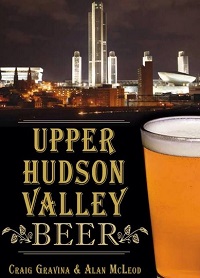 This weekend will find me at Albany attending the New York State Brewers Association second annual Craft New York Brewers Festival. The most exciting thing is that it is being held at a place called The Desmond Hotel. It is exciting because I love 1960’s first wave ska and, according to my notes, every band had to have a guy called Desmond in it. At least the great ones did. I am going to head south for the first time since September to man a chair at a table to see if I can help Craig spread the good news about our history of Albany ale as folk spin around the dance floor to these sorts of song stylings.
This weekend will find me at Albany attending the New York State Brewers Association second annual Craft New York Brewers Festival. The most exciting thing is that it is being held at a place called The Desmond Hotel. It is exciting because I love 1960’s first wave ska and, according to my notes, every band had to have a guy called Desmond in it. At least the great ones did. I am going to head south for the first time since September to man a chair at a table to see if I can help Craig spread the good news about our history of Albany ale as folk spin around the dance floor to these sorts of song stylings.
The Craft New York Brewers Festival will bring together 40 New York Breweries (and brewers) from every region of the state featuring up to 90+ hard to find and award winning beers. To make this very special event more exclusive, we will feature food sampling and pairing from local Albany restaurants and food vendors to go along with each brewery attending at no extra cost! This is a great opportunity to meet the NYS brewers that make the beer, and the owners of the local food scene in the Capital District that are such an important part of the community.
So, what do I do with the opportunity? I am not all that keen on fests as drinking sessions but I do look forward to having some decent conversations with folk in the trade. Its tied to the Association’s winter meetings. What to do? I might ask for a glass of gin. I might try an informal survey on what beer to pair with Anjou pears. Always wondered about that. Perhaps I might inquire as to what business strategies they have to better support better arm’s length beer business writing. Might expect the answer to be “what the hell is that?!?” though, mightn’t I. Frankly, the real question I want answered this weekend is whether anyone has been subject to section 3.11 of the NYSBA’s bylaws: Membership in the NYSBA, may be revoked by a majority vote of the Board of Directors for non-payment of dues, conviction of a felony or crime of moral turpitude, or willful violation of any other provision of the By-Laws of the NYSBA.. Crimes of moral turpitude? What the heck is that? Wonder if any of the members know. Might walk around asking members if they know anything about that. Perhaps it has some thing to do with unholy collaboration projects. That sort of thing. Evil.
Say hello if you are around the Des. After 8 pm, I understand, known as El Des.
Some Thoughts: Month One Of James Vassar’s 1808 Day Book
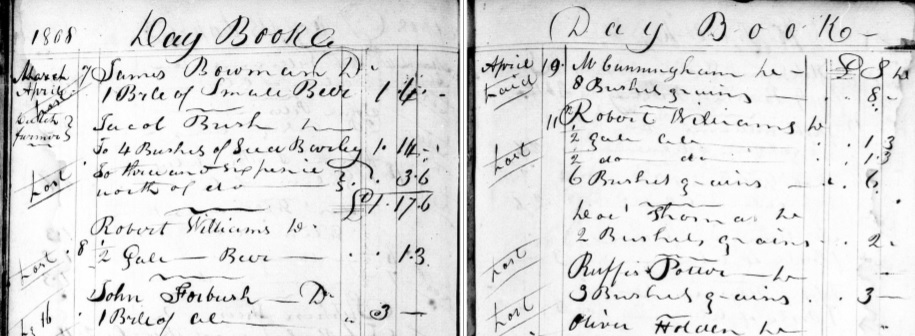 I have started a winter project. I am transferring the data in the 1808 Day Book kept by James Vassar‘s brewery at Poughkeepsie NY into a spreadsheet to allow me to grind the data to see if I can learn anything. Careful readers will remember that two and a half years ago (Good Lord!) I posted about the brewing log from his son Matthew Vassar‘s days heading his own brewery in the mid-1830s. That book described ale batch after ale batch, details the particulars of each session. It traces seventeen or so stages from heating the water to selling the barrels. The log that starts in March 1808 log is different. Being earlier and prior to the advent of things like agricultural societies, it is slightly pre-scientific. It is a business general ledger showing purchases and sales, identifying customers and suppliers as well as the prices of supplies bought and ale barrels sold. I hadn’t expected to see things worth reporting on after just copying the first month’s worth of entries but here’s what I see so far:
I have started a winter project. I am transferring the data in the 1808 Day Book kept by James Vassar‘s brewery at Poughkeepsie NY into a spreadsheet to allow me to grind the data to see if I can learn anything. Careful readers will remember that two and a half years ago (Good Lord!) I posted about the brewing log from his son Matthew Vassar‘s days heading his own brewery in the mid-1830s. That book described ale batch after ale batch, details the particulars of each session. It traces seventeen or so stages from heating the water to selling the barrels. The log that starts in March 1808 log is different. Being earlier and prior to the advent of things like agricultural societies, it is slightly pre-scientific. It is a business general ledger showing purchases and sales, identifying customers and suppliers as well as the prices of supplies bought and ale barrels sold. I hadn’t expected to see things worth reporting on after just copying the first month’s worth of entries but here’s what I see so far:
• The record may confirm that he was still brewing with the local wheat as the Dutch in the Hudson Valley had been since for almost 200 years. For the first four weeks he notes purchases of “grain” by the bushel from a number of sources. Then in the second week of April he buys “seed barley.” Why note the sort of grain only that one time otherwise? In January 1809, there is an entry for the purchase of rye. What indeed is “grain”?
• He seems to know most of the people he is dealing with. Only two receive special notation. One supplier of grain is noted as “Dutch Farmer” while another, William Jackways, is stated to be from “Rhine Beek.” Most of the others are both repeatedly referenced in the book as well as listed without citation, some without even a first name like Mr. Cunningham and Dr. Thomas. Rhinebeck NY is across the Hudson and maybe tent to twelve miles north of Poughkeepsie. Why did the man from Rhinebeck come that far? Who knows but he bought 13 barrels of ale for 39 pounds. By more than ten times, the biggest sale of the first few weeks.
• As I noted on Facebook, cross referencing the brewery logs to other web based documents like cemetery records helps identify the some of the guys who are buying beer from Vassar in 1808. It seems that a rather good class of chap likes Vassar’s ale. One Thomas Oakley, likely this one, buys a half gallon of ale on 19 March for just one shilling, 3 pence. That’s a growler in today’s measures. He’s the eighth account entry on that day busy with grain deliveries. It’s also the year before he marries, he is a twenty-five year old lawyer early in his career and long before he is in Congress. It was a Saturday. Good for you, Tom.
• On that same March 19th, Vassar buys 14 pounds of hops from Thomas Harden. The price is 1/6.1.1 which I am not quite clear about. Maybe one pound six shillings and change? We can leave it at that. No, in June he buys 93 pounds of hops from someone else and the rate is given there as 1/7 or one shilling and six pence per… whatever… and then the price paid of seven shillings and seven pence. it seems to be that hop prices are bargained for while grains are bought for a straight shilling per bushel. Hops by weight but grain by volume. Note that.
• One man who both buys and sells beer is only listed as Mr. Cunningham. Likely he is Garwood Cunningham, landlord of the Poughkeepsie Hotel. It was the successor of the Van Kleeck House – note that name – which was the first tavern in Poughkeepsie, and was kept as such for nearly a century. It was built in 1797. Garwood himself was quite a lad:
CUNNINGHAM, GARWOOD H., son of Garwood and Mary, became a man of considerable importance in Woodbury, as a military officer, and Major of the 13th Regiment of Infantry. Representative to the General Assembly from Woodbury, three sessions; twice in 1799, and once in 1801 ; also a selectman, &c, and sheriff’s deputy many years in Litchfield County. He m. Sarah Hawkins, of Derby, Conn., a sister of Joseph Hawkins. He removed early in the 18th century, to Poughkeepsie, New York, where he remained several years as keeper of the principal hotel there. In the war of 1812, he was connected with the American army, near Canada, where he was taken sick and died;
Looks like he was an officer in both wars. He also may have had a son called Garwood. He sells Vassar grain in seven separate ten bushel batches in that first month and buys six full barrels of ale throughout that first month. Not only does he have the hotel but he keeps a farm.
That is it for now. Expect more as the winter weather ebbs and flows. Or flows and ebbs. I have a sense that both the economics of running a brewing business in 1808 are right there to be spun out and perhaps also a significant part of the life of a small community in the early days of the new nation. One fellow recorded, Rufus Potter, ran for election as a village trustee in 1811. Another, Oliver Holden, was President of the Board of Village Trustees in 1825 when one Matthew Vassar, son of James, also sat on that body. Fabulous.
Book Tour Tales: Why Do I Love Upstate New York?
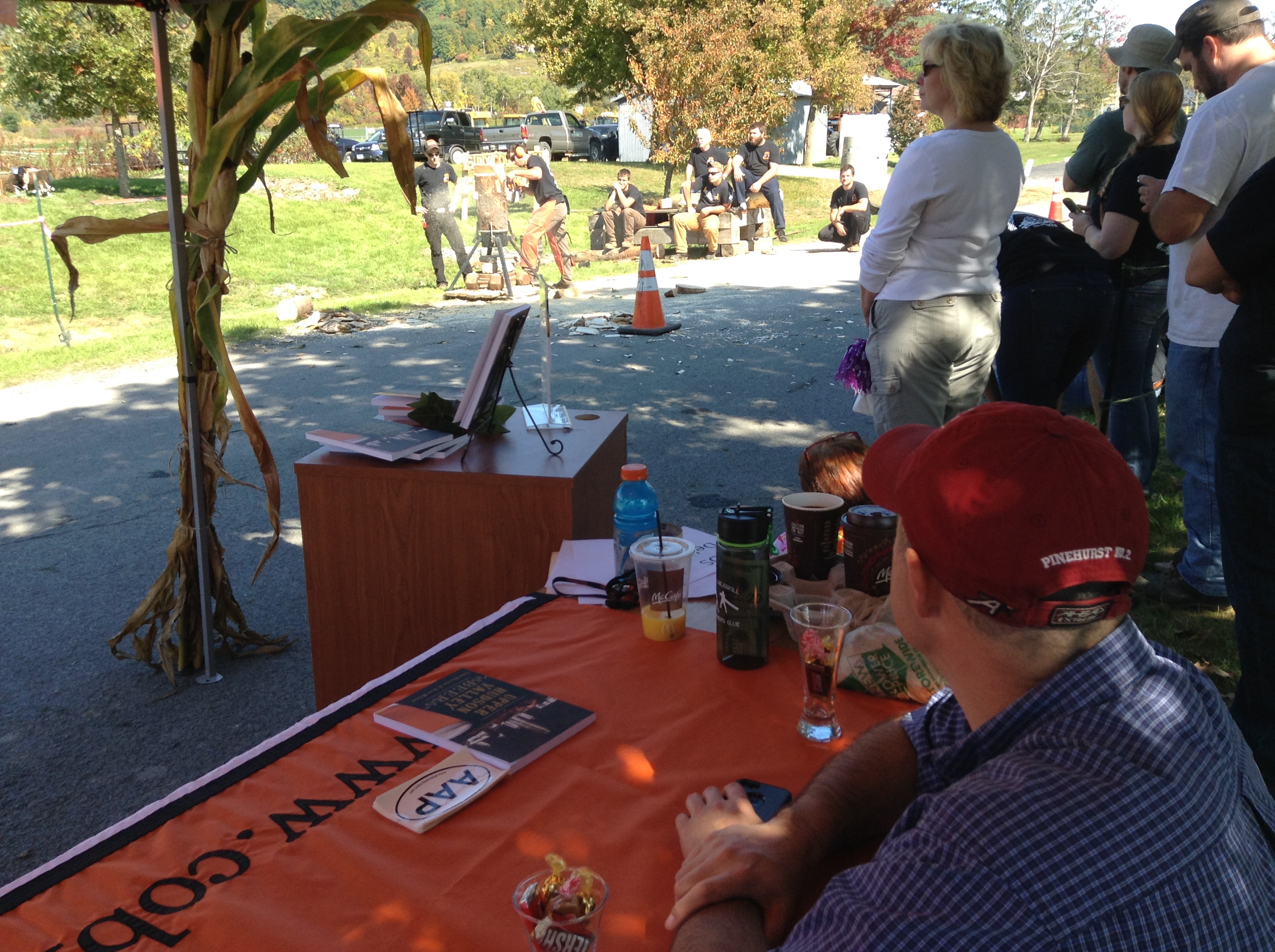
Back home. Been in the USA since Thursday and, unlike a lot of you who have to cross an ocean or get out a map, I was able to hit three grocery stores on the way home. See, I live 37 minutes from the international Thousand Islands Bridge, the most beautiful border crossing on the planet. So I bought laundry soap. But unlike most trips into the nearby Empire State, the family was not in tow. I don’t take off in another direction all that often. Which means I had a lot of time in the car to think about stuff. Or at least stuff other than where Mr. Bunny had gotten himself to. It’s always under the swim bag, by the way.
I had all the time in the world to think about what attending the SUNY Cobleskill event Grain to Glass meant. It certainly was the opposite of that stunned big craft celebrity brewer neediness. The room was full of people interested in becoming better brewers, better hop growers, better business people. It was also held on alumni weekend at the school, largely an agricultural college. There were chain saw demonstrations as illustrated past the corn stalk. There was free pulled pork from the hospitality school students, classrooms of diesel engine repair classes to check out and a whole bunch of other stuff. Beer was a topic among topics. It was a trade. It was placed in its proper place. A hipster free zone where no one gave a rat’s ass about the next PR twisty line coming out of the national Brewers Association board. Excellent.
Then, there was thinking about where I fit in to that proper place. People were really interested at that event and the others Craig and I attended about their region, their history and their beer. Beer was part of their culture. They were not there to learn about their niche hobby. There was no beer community. There was beer in the community. So, they wanted to know about traditional hops as opposed to new hybrid flavoured hops. Folk there – like at the other events – want to know about US ale brewing history, how there was two centuries of beery life before lager. It’s good to imagine how brewers in training might want to emulate those who came before them instead of some big craft guy who they see on YouTube or a TV ad. Are you picking up a theme?
One of the real treats of the trip was talking with a guy who has run a bar called The Lionheart for a quarter of a century who has found the way to sell three dollar pints of US craft beer while making a good living. A lot of it has to do with running a good bar with great staff but a lot of it also has to do with ignoring the next big thing that never turns out to be the next big thing. Taking care. Supporting local. Looking for value. Remembering the customer pays the bills not the suppliers. Including different sorts of clientele. Serving a mix of clients was also the obvious decision Browns of Troy which was running a charity event in another section of the brewery while we were holding forth in another space talking about the city’s brewing heritage. In a third section, the bar crowd were kicking back Brown’s great oatmeal stout or an IPA made on site as Jeter played his last game for the Yankees on the big screen. And as the Giants beat the Washington Whatchamacallits on another.
What’s it all mean? Why do I bother spending holiday time and more money on discount hotels than I will ever make on the book to visit again and again. I was telling someone how weird it is studying and writing about the history of a city I have no personal connection with. Yet when I am there – whether it is Troy or Cobleskill or Syracuse or up in the North Country – it feels like a place that is entirely normal. Not to mention beautiful. Yesterday afternoon I cut out of the SUNY event to take three hours to doddle my way over to Syracuse on a warm Saturday afternoon care of route 28 then along route 20 to route 92. Changing leaves. Pre-interstate main roads though small towns, along river valleys over rolling hills farmed for generations. Took me through watersheds that meet the ocean at Baltimore, New York and east of Montreal. Bought a hot dog at a Stewart’s.
Reading what I just wrote, if I am Stan I might think about how beer comes from this place and with the farmstead brewing and hop yards and cideries there is a lot to be said for that. But it is also a great place that you can learn about through its beer, its bars and its breweries. Beer isn’t a community. It is a window through which you can get to know about a community. That is why I am actually optimistic. You may not catch that from time to time but I do disagree with the idea posted by Boak and Bailey last week that beer is not as rich a seam as food, or music, or film. Beer is as rich but you have to know what beer isn’t to appreciate the point. Beer is not passive and it is not haute or elite. It is pervasive and innocuous. When we say beer is like bread we have to remember it is really like bread. An everyday thing. But we live and have lived in the everyday for hundreds and thousands of years in communities built around the brewery as much as the church and the town hall. That’s what people do as they do other stuff with their lives. Like these guys who you can see in the background of the picture above. People of the beer, I’d say.
Did Hipsters In The 1850s Like Adulterated Beer, Too?
 This is a pretty interesting bit of news in the New York Post:
This is a pretty interesting bit of news in the New York Post:
The scientists discovered the glass “California Pop Beer” bottle on Bowery Street near Canal Street, where a popular beer hall, Atlantic Garden, bustled in the 1850s, scientists said. “It’s a light summer drink, slightly minty and refreshing” said Alyssa Loorya, 44, president of Chrysalis Archaeology, which headed the project. The beer is infused with ginger root, sarsaparilla and wintergreen oil, and other herbs, giving it a one-of-a-kind kick, Loorya said.
If the beer bottle collector nerds are to be trusted, California Pop Beer was produced as Haley & Co. Celebrated California Pop Beer out of Newark, New Jersey… but apparently sometimes in New York as well. The archaeologists reproduced the beer based on research that led to finding a patent for the stuff. I suspect that. I suspect something about it all. I am suspicious. Seems a bit weird that you would get a patent for a beer when every other brewery in the world relies on and has relied on trade secrecy as opposed to a patent telling the whole world about what goes into the bottle. Fortunately, someone in the Google Borg decided we should all have access to patents so we can have a look at what went into this stuff at least in 1872. Hmm…. not really beer. A yeast and an extract of wintergreen, sassafras and spruce are prepared and then, if I read correctly, they are combined with “ten gallons of water one hour, after which seventy pounds of granulated sugar”. Or maybe 105 gallons. Yum? Does it matter?
What is most interesting to me is that this is an example of a second half of the 1800s popular beverage. It relies upon the word “beer” but really is more like a an alcopop or cooler. It comes from a time when, like today, purity is less important than flavour. It also plays upon California in the branding right about when Quinn & and Nolan in Albany, New York were advertising their California Pale XX and XXX Ales. Maybe California was just neato right about then. I like the idea that spruce is part of the taste profile. An old regional favorite flavor that you can learn more about if you BUY THIS BOOK. Oh. That was a bit gratuitous, wasn’t it.
Never mind that. The point remains. The past is a foreign land and so were their drinks.










